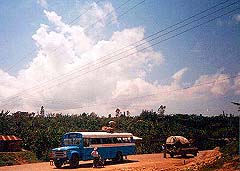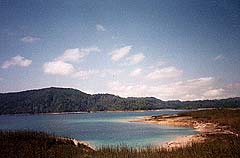Don’t worry if tourism hotspots like Acapulco or Cancun are not your cup of tea. Mexico has many `hidden’ treasures unspoiled by mass tourism. The Parque Nacional Lagunas de Montebello, also known as Lagos de Montebello, is one of these beauties.
How to get there
My travel partner and I vowed to visit the park after being enchanted by the stories of a 40-something Californian hippy, who we met on a visit to the famous Popocatepetl volcano. Having travelled Mexico extensively for nine years he spoke passionately about the Lagos de Montebello and Tziscao, located in Southern Chiapas. The beauty of the lakes and friendliness of the people charmed him and he always visited the lagos during his yearly ‘South of the Border’ trip. Coming from Palenque, and on our way to Guatemala, my travel partner insisted on exploring the park and getting ‘off the beaten path.’ Although anxious to visit Guatemala I agreed…leading to one of my most memorable experiences during our four-month Central America trip.

The Lagos de Montebello national park has 60 lakes and is definitely worth a visit if you are looking for peace and tranquillity…. or want to make a stopover en route to Guatemala. The best way to get there is by catching a bus from the Chiapan town of Comitan. It takes you along the Pan-American Highway to the indigenous town of Tziscao, located in the park. No entrance fee is required. This day trip can also be made from the Mayan town of Palenque, but be prepared for a busy day as the ride takes about four hours.
The Lakes: From Turquoise to Emerald Green
Surprisingly, my travel partner and I were the only bus passengers and our trip took about 1¼ hours, uninterrupted by police or military checks. You won’t know you’re in Tziscao until the bus suddenly veers off the Pan American highway and stops at a small intersection. You will then be asked to leave the bus as it’s the final stop, but there is no ‘Welcome to Tziscao’ sign indicating that you are there. Tziscao’s inhabitants however will greet you with a friendly ‘hola’ which made me feel very welcome. Huts bordering the dirt road veering off to the left of the intersection seem to make up the center of Tziscao as there is no central zocalo.

The dirt road on the right leads to the beautiful turquoise colored Laguna Tziscao that will take your breath away. This large, magnificent lake is a perfect place for discovering the hilly surroundings. Chances are you will not run into anyone, except for a few Guatemalans also attracted by the park’s beauty. An official border checkpoint near the lake is lacking, so crossing the Mexican/Guatemalan border here is tempting. Entering Guatemala without a visa however will displease the authorities. If one day of ‘lago walking’ is not enough for you a basic hostel and camping ground nearby can lengthen your stay.
About a fifteen minute walk from the Laguna Tziscao are the Cinco Lagunas. The lakes’ colors range from turquoise to emerald green. The scenery reminded me of Europe and for awhile I felt like being in Switzerland. What an amazing experience! An official hiking path between the lakes provides an opportunity for nice walks and lets you enjoy the area’s peace and tranquility. I only went up the path for about 15 minutes, after which I headed back to the lakes, but the hiking area is so large you can easily roam around for a couple of hours. As the area is remote my advice is to not do this on your own. Discovering the park on horseback is also an option. Don’t worry about looking for the horses…they will find you. Actually their owners will. They’ll offer you a horseback tour repeatedly. If horses are not your favorite animals, make sure you disappear from the ‘hombres’ vision range. Failing to do so only lengthens their invitation.
Mayan Surprise
Besides a piece of gorgeous nature the Parque Nacional Lagunas de Montbello also offers a magnificent section of Mayan culture, the Chinkultic ruins. Situated on the far western edge of Mexico’s Maya area, its occupation is thought to have started around 200 AD, continuing until after 900 AD. Only a few parts of the 200 mounds scattered over this region have been cleared, but are very impressive and worth a visit. Chinkultic lies before the park’s entrance, so if you want to visit the ruins on your way back to Comitan your best bet is to wait in Tziscao. Bus schedules are non-existent here so be on the lookout for your next ride. Another option is to walk along the main road towards the park’s exit and catch a lift with any mini-bus or pick up truck passing your way. A few pesos will usually settle your fare. Just mention Chinkultic and the driver will drop you off at a track two km off the La Trinataria to Montebello road, thirty km from the Pan-American Highway.
Once at the track to Chinkultic be prepared for a fifteen-to-twenty minute walk. The path takes you through cornfields, stirring curiosity among farm workers, as visitors are not often seen here. A friendly ‘buenos dias’ however will break the ice. Approaching the ruins’ entrance gate, take the track behind the hut on the left hand side. It guides you to an overgrown hill with one of Chinkultic’s major structures: E23. This long ball court has some beautiful sculptures (stelea) with human figured carvings. For a view of the surrounding lakes walk back along the path and turn left passing what could be a parking area. On the hillside that comes into view you will see the El Mirador temple. Just follow the path across the stream and climb up the hill towards the temple. The breath-taking view from the top is a cherishable memory.
Political conditions in the state of Chiapas warrant travel advisory warnings from the governments of the U.S. and Canada. Tourists, however, generally aren’t in danger, if they’re not involved in political activity. I didn’t experience hostile attitudes or sense any danger during my travels, but due to the remoteness of the area, I would not travel there alone.

